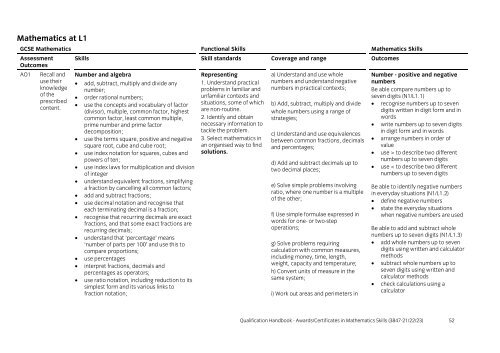Awards/certificates in mathematics skills (3847-21/22 ... - City & Guilds
Awards/certificates in mathematics skills (3847-21/22 ... - City & Guilds
Awards/certificates in mathematics skills (3847-21/22 ... - City & Guilds
Create successful ePaper yourself
Turn your PDF publications into a flip-book with our unique Google optimized e-Paper software.
Mathematics at L1<br />
GCSE Mathematics Functional Skills Mathematics Skills<br />
Assessment Skills Skill standards Coverage and range Outcomes<br />
Outcomes<br />
AO1 Recall and<br />
use their<br />
knowledge<br />
of the<br />
prescribed<br />
content.<br />
Number and algebra<br />
a) Understand and use whole<br />
numbers and understand negative<br />
numbers <strong>in</strong> practical contexts;<br />
• add, subtract, multiply and divide any<br />
number;<br />
• order rational numbers;<br />
• use the concepts and vocabulary of factor<br />
(divisor), multiple, common factor, highest<br />
common factor, least common multiple,<br />
prime number and prime factor<br />
decomposition;<br />
• use the terms square, positive and negative<br />
square root, cube and cube root;<br />
• use <strong>in</strong>dex notation for squares, cubes and<br />
powers of ten;<br />
• use <strong>in</strong>dex laws for multiplication and division<br />
of <strong>in</strong>teger<br />
• understand equivalent fractions, simplify<strong>in</strong>g<br />
a fraction by cancell<strong>in</strong>g all common factors;<br />
• add and subtract fractions;<br />
• use decimal notation and recognise that<br />
each term<strong>in</strong>at<strong>in</strong>g decimal is a fraction;<br />
• recognise that recurr<strong>in</strong>g decimals are exact<br />
fractions, and that some exact fractions are<br />
recurr<strong>in</strong>g decimals;<br />
• understand that ‘percentage’ means<br />
‘number of parts per 100’ and use this to<br />
compare proportions;<br />
• use percentages<br />
• <strong>in</strong>terpret fractions, decimals and<br />
percentages as operators;<br />
• use ratio notation, <strong>in</strong>clud<strong>in</strong>g reduction to its<br />
simplest form and its various l<strong>in</strong>ks to<br />
fraction notation;<br />
Represent<strong>in</strong>g<br />
1. Understand practical<br />
problems <strong>in</strong> familiar and<br />
unfamiliar contexts and<br />
situations, some of which<br />
are non-rout<strong>in</strong>e.<br />
2. Identify and obta<strong>in</strong><br />
necessary <strong>in</strong>formation to<br />
tackle the problem.<br />
3. Select <strong>mathematics</strong> <strong>in</strong><br />
an organised way to f<strong>in</strong>d<br />
solutions.<br />
b) Add, subtract, multiply and divide<br />
whole numbers us<strong>in</strong>g a range of<br />
strategies;<br />
c) Understand and use equivalences<br />
between common fractions, decimals<br />
and percentages;<br />
d) Add and subtract decimals up to<br />
two decimal places;<br />
e) Solve simple problems <strong>in</strong>volv<strong>in</strong>g<br />
ratio, where one number is a multiple<br />
of the other;<br />
f) Use simple formulae expressed <strong>in</strong><br />
words for one- or two-step<br />
operations;<br />
g) Solve problems requir<strong>in</strong>g<br />
calculation with common measures,<br />
<strong>in</strong>clud<strong>in</strong>g money, time, length,<br />
weight, capacity and temperature;<br />
h) Convert units of measure <strong>in</strong> the<br />
same system;<br />
i) Work out areas and perimeters <strong>in</strong><br />
Number - positive and negative<br />
numbers<br />
Be able compare numbers up to<br />
seven digits (N1/L1.1)<br />
• recognise numbers up to seven<br />
digits written <strong>in</strong> digit form and <strong>in</strong><br />
words<br />
• write numbers up to seven digits<br />
<strong>in</strong> digit form and <strong>in</strong> words<br />
• arrange numbers <strong>in</strong> order of<br />
value<br />
• use > to describe two different<br />
numbers up to seven digits<br />
• use < to describe two different<br />
numbers up to seven digits<br />
Be able to identify negative numbers<br />
<strong>in</strong> everyday situations (N1/L1.2)<br />
• def<strong>in</strong>e negative numbers<br />
• state the everyday situations<br />
when negative numbers are used<br />
Be able to add and subtract whole<br />
numbers up to seven digits (N1/L1.3)<br />
• add whole numbers up to seven<br />
digits us<strong>in</strong>g written and calculator<br />
methods<br />
• subtract whole numbers up to<br />
seven digits us<strong>in</strong>g written and<br />
calculator methods<br />
• check calculations us<strong>in</strong>g a<br />
calculator<br />
Qualification Handbook - <strong>Awards</strong>/Certificates <strong>in</strong> Mathematics Skills (<strong>3847</strong>-<strong>21</strong>/<strong>22</strong>/23) 52
















